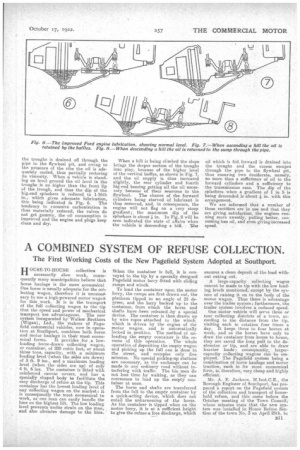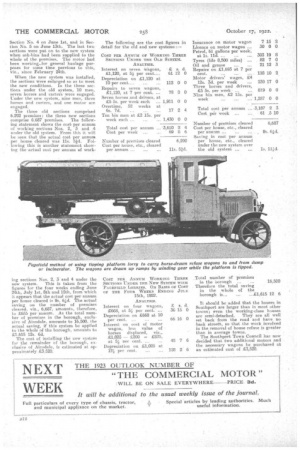A COMBINED SYSTEM OF REFUSE COLLECTION.
Page 11

Page 12

If you've noticed an error in this article please click here to report it so we can fix it.
The First Working Costs of the New Pagefield System Adopted at Southport.
HOUSE-TO-HOUSE collection is necessarily slow work, consequently many municipalities. believe that horse haulage is the more economical One horse is usually adequate for the collecting wagon therefore it is unneceesary to use a high-powered motor wagon for this ,work. It is in the transport of the lull collecting wagon to the tip that the speed and power of mechanical transport are advantageous. The new system inaugurated by Walker Brothers .(Wigan), Ltd., the makers of Pagefield commercial vehicles, now in operation . at Southport, combines both horse and motor haulage in their most econo mical forms. It provides for _a lowloading horse-drawn collecting wagon, or container, of 200 cubic feet, or about three tons, capacity, with ,a minimum loadinglevel(when the aides are down) of 3 ft. 9 ins., and a maximum loading level (when the sides are up) of only 4 ft. 6 ins. The container is fitted with reinforced canvas covers, and has a specially shaped body to facilitate the easy discharge of refuse at the tip. This container has the lowest loading level of any collecting wagon on the market : it is consequently the most economical to work, as one man can easily handle the bins on the highest lift. The low loading level prevents undue strain on the man, and also obviates damage to the bins.
When the container is full, it is conveyed to the tip by a specially designed Pagefield motor lorry fitted with sliding ramps and winch.
To load the container upon the motor lorry, the ramps are first drawn out, the platform tipped to an angle of 25 degrees, and the lorry backed up to the container, from which the horse and shafts have been released -by a special device. The container is then drawn up by wire ropes attached to the winch, which is driven by the engine of the motor wagon, and is automatically locked in position. The method of unloading the empty container is the reverse of this operation. The whole operation of depositing the empty wagon and picking up the full one is done in The street, and occupies only five minutes. No special picking-up stations are necessary, as the exchange can be made in any ordinary road without interfering with traffic. The bin men do not lose time by waiting, as they can commence to load up the empty container at once.
The horse and shafts are transferred from the full to the empty container by a quick-acting device, which does not entail the unharnessing of the horse. As the container is tipped when on the motor lorry, it is at a sufficient height to give the refuse a free discharge, which ensures a clean deposit of the load without raking out.
A large-capacity collecting wagon cannot be made to tip with the low loading levels mentioned, except by the system of raising it on to the body of the motor wagon. Thus there is advantage over the trailer system; furthermore, the trailer system involves a reduced speed. One motor vehicle will serve three or tour collecting districts of a town, according to the distance from the tip, visiting each in rotation four times a day. It keeps three to four horses at work, and as the horses have only to draw the container from house to house, they are saved the long pull to the destructor or tip, and are able to draw heavier loads ; consequently, largercapacity collecting wagons can be employed. The Pagefield system being a combination of horse haulage and motor traction, each in its most economical form, is, therefore, very cheap and highly efficient.
Mr. A. E. Jackson, M.Inst.C.E., the Borough Engineer of Southport, has prepared a report on the Pagefield system of the collection and transport of household refuse, and this came before the October meeting of the Town Council, whose minutes state that the new aye. tern was installed in House Refuse Section of the town No. 3 on April 25th, in Section No. 4 on June 1st, and in Section No. 5 on June 13th. The last two sections were put On to the new system when ash-bins had been supplied to the whole of the premises. The motor had been working_for general haulage purposes for some time previous to this, viz., since February 24th.
When the new system was installed, the sections were enlarged so as to meet the new conditions. In the three sections under the old system, 10 men, seven horses and carters were engaged. Under the new system, nine men, three horses and carters, and one motor are engaged.
The three old sections comprised 6.292 premises; the three new sections
comprise 6,687 premises. The follewing statement shows the cost per annum of working sections Nos. 2, 3 and 4 under the old system. From this it will be seen that the actual cost per annum per house cleared was 11s. 5id. Following this is another statement showing the .actual cost per annum of work
ing sections Nos. 2, 3 and 4 under the new system. This is taken from the figures for the four weeks ending June 24th, July 1st, 8th and 15th, from which it appears that the actual cost per annum per house cleared is 9s. 64d. The actual saving OD the number of premises cleared, viz., 6,687, amounts, therefore, to £655 petannum. As the total number of premises in the borough. exclusive of Ainsdale, amounts to 16,500, the actual saving, if this system be applied to the whole of the borough, amounts to £1.615 12s. 6d.
The cost of installing the new system for the remainder of the borough, exclusive of Ainstlale, is estimated at approximately. £3,520. The following are the cost figures in detail for the old and new systems ;—
COST PIM ANNUM OF WORKING THREE SECTIONS UNDER THE OLD SYSTEM.
COST PER ANNUM 1.757ORKING THREE SECTIONS UNDER THE NEW SYSTEM WITH PAGETIELD LORRIES. ON BASIS OF COST OE THE FOUR WEEKS ENDING JULY
15th, 1922.
ANALYSIS.
Interest on four wagons, s. d. £668, at 51 per cent. ... 36 15 0 Depreciation on £668 at 10 per cent. ... 66 16 0 Interest on cost of motor wagon, less value of horses displaced, viz., £1,025 — £200 = £825, at 51 ner cent. ... 45 7 6 Depreciation on £1,025 at 121 per cent. ... 128 2 6 Number of premises cleared 6,687 Cost per house, etc., cleared per house, etc., cleared . under the new system over the old system.„ is. 11A.
Total number of premises in the borough ... 16,500 Therefore the total saving in the whole of the borough is... ... ...£1,615 12 6 It should be added that the houses in Southport. are larger than in most other towns; even the working-class houses are semi-detached. They are all well set back from the road and have no back streets, so that the work involved in the removal of house refuse is greater than in average towns. The Southport Town Council has now decided that two additional motors and the necessary wagons be purchased at an estimated cost of £3,520.
































